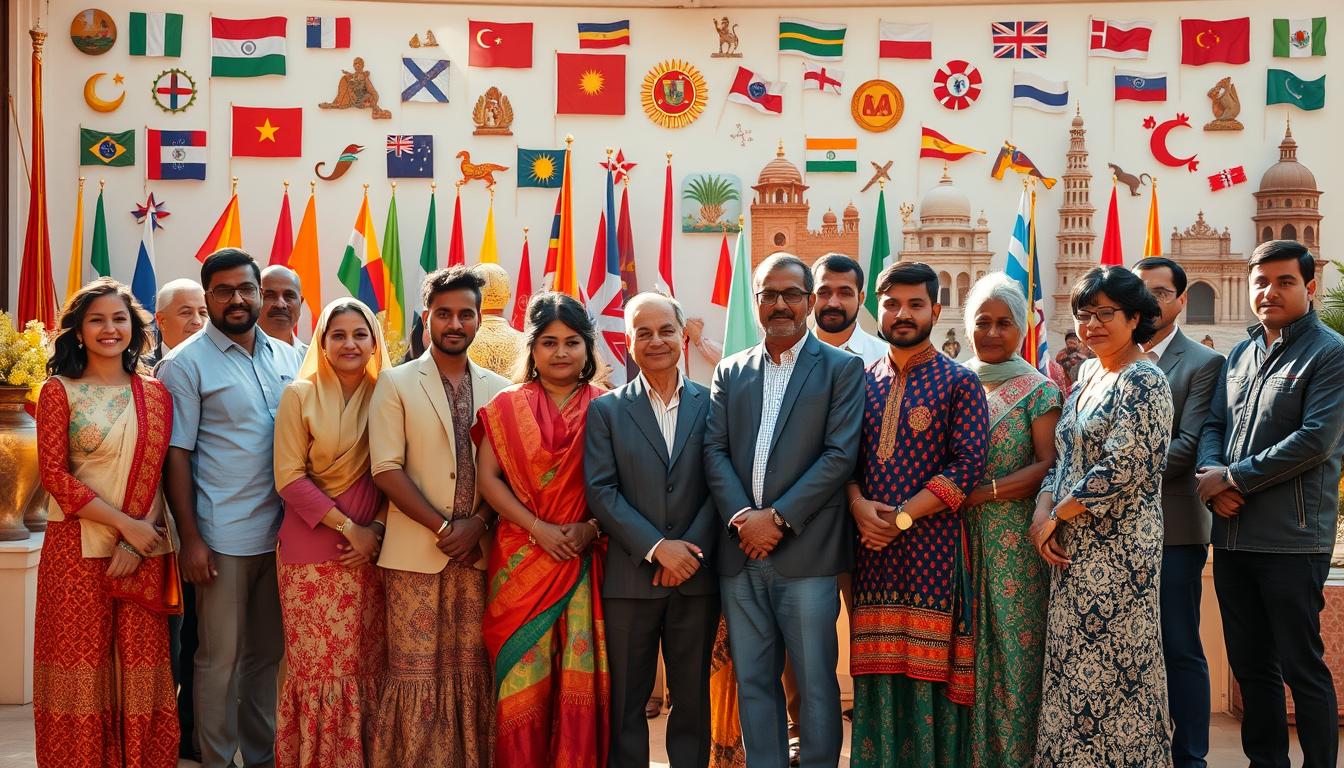Bridging Cultures: Empowering Youth Leadership through Global Exchange
In today’s world, youth leadership is more important than ever. Global exchange programs are key in this growth. They give young people chances to learn and grow.
By exploring different cultures, they gain valuable skills. These include better communication and being able to adapt. This helps them see the world in new ways and prepares them for the future.
Understanding Youth Leadership in Today’s World
Youth leadership is key in shaping future leaders. It helps them tackle complex global challenges. Young leaders show confidence, adaptability, and a strong sense of responsibility. These traits help them positively influence their peers.
Defining Youth Leadership
Youth leadership means young people inspiring and guiding others. They do this in teams or community projects. Skills like communication, empathy, and critical thinking are vital.
These skills help them share their ideas and work with different views. Developing these skills is important for young leaders to be resilient and innovative.
Importance in Multicultural Settings
In multicultural settings, youth leadership is even more important. Diverse cultural views lead to richer discussions and creative solutions. Young leaders who value cultural differences create inclusive spaces.
Studies show diverse leadership boosts team performance and sparks new ideas. By embracing different cultures, youth leaders make a bigger impact in their communities.
The Role of Global Exchange Programs
Global exchange programs are key in shaping the next leaders. They offer experiences that boost youth development. These programs let participants see different cultures, helping them become global citizens.
There are many types of global exchange programs. Each one has its own goals and ways of teaching.
Types of Global Exchange Programs
There are several types of global exchange programs. Each offers unique chances for growth:
- Study Abroad: Students can take classes in a foreign school. This lets them see new educational systems and cultures.
- Internships: Participants work in international organizations. They learn practical skills and about different work cultures.
- Cultural Immersion Experiences: These focus on understanding cultures. Activities include homestays, language classes, and community service.
Impact on Youth Development
Global exchange programs deeply impact youth development. Participants often gain:
- Increased Self-Confidence: Exploring new places boosts personal confidence and resilience.
- Enhanced Leadership Skills: Talking with peers from different backgrounds improves critical thinking and teamwork.
- Comprehensive Understanding of Global Issues: Seeing different views helps youth understand global problems. They become active in solving them.
These programs are powerful in advancing youth leadership. They help individuals grow and commit to helping others and the world.
Analyzing Successful Youth Leadership Models
Looking into successful youth leadership programs shows us a lot. They come from all over the world. Each one is special, helping young people learn to lead.
By studying these programs, we gain insights. These insights help us grow the next generation of leaders.
Case Studies of Effective Programs
Some youth leadership programs have made a big difference. For example, the U.S. State Department’s Youth Leadership Program teaches young people to tackle community issues. Global Citizen Year also offers a unique experience, letting participants see different cultures up close.
This hands-on learning helps them see the world in new ways. It teaches them to think differently and understand global connections.
Lessons Learned from International Leaders
International leaders from these programs show us the power of diversity. They’ve faced many challenges and come out stronger. Their stories teach us about being adaptable, empathetic, and resilient.
These leaders inspire young people to see challenges as chances to grow. Their paths show us the best ways to lead. They prove that young people can truly change the world.
Fostering Cultural Awareness among Youth
In a world full of diversity, teaching youth about different cultures is key. It helps them become future leaders. By joining activities that focus on understanding cultures, young people can grow. This way, they can lead with a deep appreciation for diversity.
Strategies for Cultivating Understanding
Workshops, cultural events, and community service are important. They let youth dive into different cultures. This helps build bridges and friendships across diverse groups. Here are ways to get more youth involved:
- Organizing cultural festivals that celebrate various heritages.
- Creating mentorship programs with leaders from diverse backgrounds.
- Implementing classroom activities that focus on multicultural education.
- Promoting global awareness through digital exchanges with peers from other countries.
Benefits of Cultural Awareness in Leadership
Teaching youth about cultures has many benefits. Leaders who know about different cultures solve problems better. They inspire teamwork and strengthen community bonds.
With cultural awareness, leaders can meet the needs of all people. They make sure everyone’s voice is heard and valued.
Collaborating with Educational Institutions
Educational institutions are key places for growing youth leadership skills. By working with schools and universities, organizations can build strong programs for youth leadership. These partnerships improve learning and help young people develop important life skills.
Partnerships with Schools and Universities
Creating strong ties between schools and leadership groups makes learning better. Programs like workshops and community service gain from these partnerships. Schools and universities provide access to resources, spaces, and mentors, supporting youth leadership.
Role of Extracurricular Activities
Extracurricular activities are vital for leadership growth outside school. They give students real-world chances to work together, communicate, and solve problems. Clubs, sports, and volunteer groups are key places for young people to improve their leadership and face new challenges.
Engaging the Community in Leadership Development
Local communities play a big role in shaping the next generation of leaders. They create a supportive space for youth to grow. By getting involved in leadership development, both individuals and the community benefit. Programs that connect youth with experienced leaders are key to success.
Importance of Local Involvement
Being active in local activities helps youth feel more responsible. When the community supports youth leadership, it builds a strong network of support. This support encourages growth and resilience. Key aspects of local involvement include:
- Providing resources and guidance to young leaders.
- Encouraging participation in community-based projects.
- Fostering relationships between youth and established leaders in the area.
Creating Mentorship Opportunities
Mentorship is vital in empowering youth. It introduces them to new views and lets them share their challenges. Good mentorship programs have:
- One-on-one guidance tailored to each youth’s needs.
- Workshops and training to teach essential skills.
- Networking events for young leaders to meet professionals.
By focusing on local involvement and mentorship, communities can shape the future leaders. These efforts benefit both mentors and mentees, creating a growth environment for all.
Addressing Challenges in Youth Leadership
Youth leadership faces many challenges, especially with cultural barriers and helping marginalized groups. These issues can make it hard for young leaders to work together. To solve these problems, we need strategies that promote inclusivity and understanding.
Overcoming Cultural Barriers
Cultural barriers are a big challenge in youth leadership. Good leadership means being able to talk and work with people from different cultures. Young leaders can use several ways to overcome these barriers:
- Engage in cultural awareness workshops to build understanding.
- Encourage peer-to-peer dialogue to promote shared experiences.
- Incorporate diversity training into leadership programs.
These steps improve communication skills and create a supportive environment. They help young leaders work well together, no matter their background. This way, organizations can build strong, effective teams.
Empowering Marginalized Groups
Young leaders from marginalized groups often struggle to get leadership roles. It’s important to make sure everyone has a chance. Organizations can take several steps:
- Implement outreach programs specifically targeting underrepresented youth.
- Facilitate mentorship opportunities that connect young leaders with experienced professionals.
- Develop scholarships or financial aid for leadership training programs.
By focusing on these areas, we can create a more inclusive and powerful leadership. This way, a variety of voices and experiences can shape the future. Empowering marginalized groups makes sure everyone has a chance to succeed.
The Future of Youth Leadership and Global Exchange
The world of youth leadership is changing fast. New trends in youth involvement are leading the way. With technology improving, young people are becoming key players in new leadership styles.
Digital platforms have changed how they connect and tackle global problems. This change marks a big shift in youth leadership’s future.
Trends in Youth Involvement
More and more young people are getting involved, thanks to social media and digital tools. These platforms let them share their views and rally others worldwide. Some key trends include:
- Increased digital activism: Young folks are using online tools to fight for justice and protect the environment, making their voices heard globally.
- Collaboration across cultures: Online programs help youth from different places work together, promoting understanding between cultures.
- Accessibility of information: With knowledge more available, youth can learn and join global conversations more easily.
Predicting Changes in Global Dynamics
The world is always changing, and this affects youth leadership. Important factors to watch include:
- Cultural shifts: As cultures evolve, youth leaders must adjust to new stories and views, making sure everyone’s voice is heard.
- Political transformations: Political changes will shape what opportunities youth have, requiring them to be flexible and strong.
- Technological advancements: New tech will open up fresh ways for young leaders to join global talks, changing how they engage.
Conclusion: The Path Forward for Empowering Youth Leaders
Empowering youth leaders through global exchange is more urgent than ever. Educational institutions, community groups, and governments must work together. They need to create a space where cultural diversity thrives, helping youth succeed in our connected world.
It’s time for stakeholders to take action. They should develop and support leadership programs that speak to young people’s dreams. By doing so, they can equip them with skills that benefit communities, making leadership accessible and relevant in our fast-changing world.
Our goal is to build lasting partnerships across the globe. By sharing resources and knowledge, we can empower youth leaders. This effort will not only boost individual skills but also help tackle global challenges, preparing the next generation to face the future with confidence and understanding.
FAQ
What is youth leadership?
Why is youth leadership development important in today’s world?
What are the different types of youth leadership programs?
How do global exchange programs contribute to youth leadership skills?
Can cultural awareness improve leadership effectiveness?
How can educational institutions support youth leadership initiatives?
What challenges do young leaders face in their development?
What is the future outlook for youth leadership and global exchange?
How can individuals get involved in youth leadership programs?
Published on: 28 de March de 2025

Luke Martin
Luke Martin, author of Credwallets.com, is a mathematics graduate with a specialization in financial markets. Known for his love of pets and his passion for sharing knowledge, Luke created the site to provide valuable insights into the complexities of the financial world. His approachable style and dedication to helping others make informed financial decisions make his work accessible to all, whether they're new to finance or seasoned investors.







